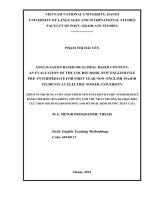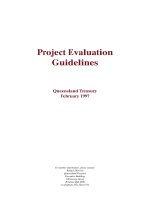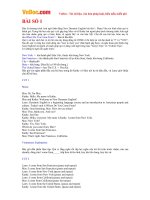New Dynamic English testing & evaluation guide
Bạn đang xem bản rút gọn của tài liệu. Xem và tải ngay bản đầy đủ của tài liệu tại đây (153.2 KB, 10 trang )
New Dynamic English
Testing & Evaluation Guide
Version 1.2 © Copyright 1999-2003, DynEd International, Inc. February 2003
Testing and Evaluation Guide
Table of Contents
Introduction 3
Mastery Tests 4
When to Take a Test 4
Types of Test Questions 5
Lexical/Grammatical 5
Listening Comprehension 5
Sentence Construction 6
Sentence Ordering 6
List of Mastery Tests by Level 7
Completion Percentage and Student Evaluation 8
Adjusting the Completion Percentage 8
Shuffler Level 9
Summary 10
© Copyright 1999-2003, DynEd International, Inc.
www.dyned.com
Testing & Evaluation Guide
3
Introduction
This guide has been prepared to introduce and facilitate the use of Mastery Tests to monitor and
evaluate student progress in the study of New Dynamic English. Used together with the Placement
Tests and Completion Percentage, the Mastery Tests help teachers determine the best pacing and
level for each student and to evaluate overall progress.
It is important to note that the Mastery Tests and DynEd Records Manager must be used together.
Access to the Mastery Tests is controlled by the teacher through the Records Manager which keeps
study and test results for each student. Teachers must unlock the tests for each class or student. It
is necessary to have a license and registration number to allow for the operation of the Records
Manager, either onto a network, a personal computer, or on the Internet. Detailed instructions
about how to use the Records Manager are in the Records Manager Guide which is in the
Documents file that comes with every installation. Click on the Documents icon to access this file.
The file is also accessible through the Help Menu in the program.
In addition to the Records Manager and Mastery Tests, users are strongly recommended to refer to
the New Dynamic English Teacher’s Guides which include invaluable suggestions about how best
to use the program. The Teacher’s Guides also include the complete scope and sequence for the
series, as well as transcripts, printable/copiable worksheets, listening task assignments, suggested
homework, and follow-up and extension classroom activities.
We hope that these new teaching tools will be useful and make your teaching experience with New
Dynamic English even more successful. Any comments or suggestions from our customers are
always welcome.
For further information on how to get a license for the DynEd Records Manager and/or Mastery
Tests, please contact your usual DynEd distributor or <>.
Testing & Evaluation Guide
4
Mastery Tests
DynEd’s Mastery Tests are achievement tests designed to help teachers evaluate a student’s
progress and confirm student mastery of unit content. There are six mastery tests for each level of
New Dynamic English, or a total of 24 mastery tests for the series. Access to the tests is controlled
through the Records Manager, where the teacher must ‘unlock’ a test before students can take it.
Each test takes from six to twelve minutes, and consists of between 20 and 50 test items.
Test items are randomly selected
from a database of relevant
questions, not all of which are
used in every test, to ensure
variation for each student and
from one test session to another.
It is important to note that the
question number shown for each
test item in a test refers only to its
place in the test sequence, and
not to the question itself, which
will be different for each student.
A student’s test score is indicated at the bottom of the test screen, and is automatically recorded in
the Student Study Records. The best possible score for each test is always 100. Generally, a score
of 80 or more is necessary to indicate that a student has mastered the target language of a unit. For
students who score less than 80, more study is advisable. Since all of the test items are taken
directly from the lessons, students who have focused on all of the lessons in a unit with any
sustained effort should be able to score at least 80 within the allotted time, provided they have
reasonable reading and motor skills. Generally the class average for a test should be 90 or greater.
For grading purposes the scores might translate as follows:
96~100 = A or Excellent 90~95 = B or Good
85~89 = C or Satisfactory 80~84 = D or Unsatisfactory Pass
0~79 = F or Not Pass
When to Take a Test
Generally, students should take a Mastery Test when they (or the teacher) feel they have
sufficiently mastered the language in a unit. For most students this will generally be when their
Completion Percentage is between 80~100 for each lesson in the unit. Of course, this varies
according to the student’s initial level and linguistic background, as noted in the section about
Completion Percentages.
Once the teacher decides to have students take a Mastery Test, the teacher must use the Records
Manager to unlock (grant access to) the particular test for the Unit to be tested. Once the test has
been taken, teachers should not allow students to take the test again until enough time has passed
to ensure that test items have not become memorized or overly familiar to the student. Generally,
tests will automatically relock once they have been taken.
Test results for each student will be found in the Records Manager within each student’s
individual study records and within the Unit which was tested. Students can also see their test
scores in their own Student Records, which they can view at anytime when they are in the course.
Testing & Evaluation Guide
5
Types of Test Questions
There are several types of questions in each Mastery Test, ranging from multiple-choice, listening
comprehension, sentence construction, to sentence ordering.
Lexical/Grammatical
This multiple choice type of
question generally focuses on
vocabulary or grammar points,
such as which form of a verb to
use. Students read a sentence
and then indicate which of four
choices correctly completes the
sentence.
These questions are timed, and students have two chances to answer them. If students get the
correct answer on their first try, they get a full score. If they get the correct answer on their second
try, they get a partial score. The cumulative score is shown at the bottom of the test screen.
Listening Comprehension
A second type of question focuses
on listening comprehension. For
example, the student may hear a
question or statement and have to
answer or complete it with the
correct choice.
In these types of questions, the
student has only one chance to
get the correct answer. If the
answer is correct, the program
will repeat the answer or give a
rejoinder and go on. If the
answer is incorrect, the program
will indicate that it is wrong and
then go on to the next question.
If a question times out, the
question will be repeated once.
If the question times out a
second time, the program will
move on to the next question.
Testing & Evaluation Guide
6
Sentence Construction
In the third type of test item, students are asked to move a set of words into the correct places
within a sentence. Though these tasks are difficult for someone who hasn’t studied the lesson, in
every case the sentences come directly from the lesson and will be familiar to students who have
spent sufficient time in the unit. In fact, many of these questions come directly from the Focus
Exercise lessons.
In this type of test item, students have two chances to complete a sentence. If they are correct on
their first attempt, they get full credit. If they are correct on their second attempt, they get partial
credit. Students are also allowed to time out once before the program moves on to the next item.
Sentence Ordering
In New Dynamic English, Modules 7 and 8, two of the Mastery Tests have sentence-ordering
items. These come directly from the lessons, and should therefore be familiar to all students who
have studied in depth the lessons from those units.
In these items, students should
read the sentences and then
decide the order. In this
example, sentence B comes first,
followed by A and C.
These items test a student’s
ability to see how items within
one sentence refer to items in
other sentences.
Testing & Evaluation Guide
7
List of Mastery Tests by Module
Module 1: Names & Places 8 minutes, 25 questions
Jobs & Family 8 minutes, 25 questions
Numbers & Times 8 minutes, 50 questions
Module 2: Family Schedule 9 minutes, 25 questions
Matrix Vocabulary 8 minutes, 20 questions
Likes & Dislikes 8 minutes, 25 questions
Module 3: Daily Activities 8 minutes, 25 questions
Our World 8 minutes, 25 questions
Locations 8 minutes, 30 questions
Module 4: Planning Ahead 8 minutes, 20 questions
Matrix Vocabulary 8 minutes, 20 questions
Biography 8 minutes, 20 questions
Module 5: On a Trip 8 minutes, 25 questions
Energy Sources 9 minutes, 25 questions
Directions 9 minutes, 25 questions
Module 6: Life Experience 8 minutes, 25 questions
Matrix Vocabulary 8 minutes, 25 questions
Comparisons 8.5 minutes, 20 questions
Module 7: Life Choices 8 minutes, 25 questions
An Epidemic 12 minutes, 25 questions
Space & Time 9 minutes, 25 questions
Module 8: A Secret Code 9.5 minutes, 25 questions
Matrix Vocabulary 10 minutes, 25 questions
UFOs: For or Against? 12.5 minutes, 25 questions
Testing & Evaluation Guide
8
Completion Percentage and Student Evaluation
The Completion Percentage is shown in the student records. It is a relative measure of the quality
and depth of study in each unit of the course as compared to a baseline student with no prior
English study at or above the placement level and whose native language is dissimilar to English.
More importantly, the Completion Percentage score indicates how thoroughly a student has
studied and practiced each lesson. Unlike most subjects, the study of language involves at least as
much practice as study. Since language comprehension must be nearly instantaneous if oral
communication is to take place, the learning of a second language should be approached as a skill
to be acquired, and not merely an ‘understanding’ of grammar rules and vocabulary. Successful
language learning therefore requires ‘overlearning’ and considerable focused practice.
To assist students in reaching the goal of communicative competence, the Completion Percentage
score is an author-defined guideline which sets completion goals based on the following activities:
sentence repetitions, sentence recording attempts, speech recognition attempts, use of the glossary,
and the number of questions which are answered. The program counts each time a student listens
to a sentence, uses the repeat button to repeat a sentence, uses the record button to record a
sentence, consults the glossary, and answers a question. The accumulated data is analyzed and
scored according to the length of the lesson, the number of sentences and questions in a lesson, and
the kinds of activities which are appropriate in that lesson.
To reach the desired level of mastery of the materials provided within DynEd’s courses, and to
attain an 80% or more Completion Percentage, students need to go through each part of each
lesson several times in a variety of ways, as indicated in the Listening Focus tasks outlined in the
Teacher’s Guide. These tasks direct students to preview each part of a lesson, to pay attention to
different grammar and vocabulary areas, to consult the Glossary when needed, to practice saying
the sentences, and to review each part of each lesson over a period of several study sessions. If
this is done, the vocabulary and basic grammatical patterns will be successfully acquired (not just
memorized short term), and the Completion Percentage will indicate that the student should be
prepared to successfully take the Mastery Test for that lesson. A good score (80% or more) on the
Mastery Tests confirms that the student is ready to move on.
Adjusting the Completion Percentage
The weightings for the Completion Percentage scores may be adjusted up or down by a teacher
through the Records Manager if the target levels seem too high or low for the class average, or for
students who have placed significantly higher than the average but are required to study at the
same level.
For example, students who are false beginners with a considerable knowledge of English, but with
limited listening practice, will be able to move through the course much faster than true beginners
with little knowledge of the language. With such false beginners, teachers may find it
advantageous to have the Completion Percentage rise more quickly than the baseline case.
Similarly, for students whose native language background is close to English, they may be able to
master the material more quickly than students whose language background is Japanese or Arabic.
In addition, students who are taking part in frequent classes with other students in an intensive
Testing & Evaluation Guide
9
atmosphere may also move through the lessons at a faster pace than reflected in our default
settings.
The Completion Percentage figures, therefore, need to be interpreted and adjusted according to the
circumstances. Once set, however, the Completion Percentage, together with the Mastery Test
scores, will help to indicate which students are using their time effectively and which students are
skimming through the material with little or no focus. These students may benefit from individual
coaching and/or additional study materials.
The following guidelines may be useful in adjusting the Completion Percentage for your class:
Students with little or no prior English study at or above the placement level, from a language
background dissimilar to English: 100%: This is the baseline setting.
Students with little or no prior English study at or above the placement level, from a language
background similar to English: 70~80%. Adjust the initial setting to 75%. Then readjust the
setting after one or two units have been completed and tested.
False beginners with a language background dissimilar to English: Adjust the initial setting to
60~70%. Then readjust as warranted.
False beginners with a language background similar to English: 50~60%. Adjust the initial setting
to 50~60%. Then readjust as warranted.
Shuffler Level
Also shown in the student records, the Level refers to DynEd’s proprietary ‘shuffler’ mechanism
which operates to open or shut paths within a lesson. As a student answers questions, the Level is
adjusted up or down, depending on the success rate of the student. The maximum Level is 3.0.
When the level is in the range of 0-1, or 1-2, a lesson is only partially open, restricting a student’s
access to various questions and paths within the lesson. This initial restriction helps avoid
overloading students with too much information or with tasks beyond their ability. As students
become comfortable with the initial material and begin responding successfully, the Level
automatically rises, and additional material, generally with more difficult grammar and
vocabulary, is opened up to the students. Once the shuffler level reaches the range of 2-3, the
lesson is fully open so long as the student stays within that range. Should the student begin to
have trouble at a higher level, the Level will automatically fall, allowing students to focus on a
limited selection of the material before opening up the rest of the lesson.
Please note that when students are studying at a higher shuffler level, their Completion Percentage
score will increase at a slightly faster rate.
Testing & Evaluation Guide
10
Summary
In response to requests from our users, the testing and monitoring tools described in this guide
have been designed to assist with the evaluation of student progress.
The Mastery Tests help confirm that students have gone beyond a general understanding of the
target language and short-term memorization, to the next level of understanding and acquisition.
By taking the Mastery Tests, students also gain valuable practice in taking timed language tests,
which will help prepare them for standardized tests such as TOEFL, TOEIC and/or FCE exams.
The Completion Percentage is a relative measure of the quality and depth of study in each unit of
the course as compared to a baseline student with no prior English study and whose native
language is dissimilar to English. This baseline can be adjusted by the teacher to fit the
circumstances of the class. The Completion Percentage allows the teacher to determine which
students have applied themselves in each lesson, and is analogous to determining whether or not
the student has done their ‘homework’ or completed their ‘practice’ as directed in the Teacher’s
Guide.
Used together with the Completion Percentage scores, the Mastery Test scores provide an
indication of student progress and whether or not a student is ready to move ahead in the course or
would benefit from further review. Any ranking of overall student performance should, however,
take into account a variety of factors, such as classroom performance, written homework, and other
forms of teacher evaluation. Language learning is accomplished by a variety of means, with
DynEd’s courseware being only one part of the overall learning environment.
True mastery of a language, at any level, is greatly affected by the level of opportunity students
have to practice, particularly with other speakers. Sessions during which students are guided to
personalize and extend the core language of the courses they have been studying whether one on
one, or in classrooms, or in small group situations (perhaps even over the Internet through chat
rooms or video conferencing), can significantly increase the efficiency and depth of student
language acquisition.









